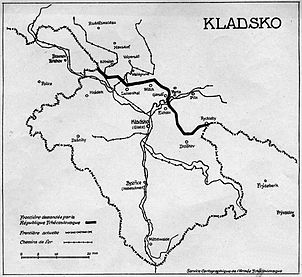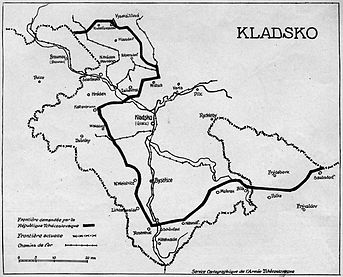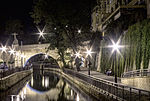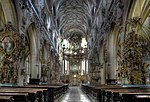Kłodzko
Kłodzko | ||
|---|---|---|
Gothic bridge and Baroque Church of Our Lady of the Rosary (top), Kłodzko Fortress overlooking the town (bottom) | ||
|
Car plates DKL | | |
| National roads | ||
| Voivodeship roads | ||
| Website | klodzko.pl | |
Kłodzko (
Kłodzko is the seat of Kłodzko County (and of the rural Gmina Kłodzko, although the town itself is a separate urban gmina), and is situated in Lower Silesian Voivodeship. With 26,845 inhabitants (2019), Kłodzko is the main commercial centre as well as an important transport and tourist node for the area.
For its historical monuments it is sometimes referred to as "Little
History
Prehistory
The area of present-day Kłodzko has been populated at least since the 1st century BC. There are several archaeological sites both in and around the town that indicate that there must have been a settlement located on the ancient Amber Road that conducted extensive trade relations with the Roman Empire.
Medieval Bohemia and Poland
The earliest mention of the town is in the 12th-century
In 1241, Klodzko became the site of a Mongol raid during the
German
County seat within Bohemia

Kladsko developed rapidly until the start of the Hussite Wars in the 15th century. The wars left the town depopulated by plagues, partially burnt, and demolished by several consecutive floods. In 1459 whole Kłodzko Land was elevated by Bohemian king George of Poděbrady to the status of county – thus the city became a seat of Count (for most of time ruler of Bohemia itself) and local Diet – but still remained integral part of Bohemia as "outer region" (Czech: vnější kraj), and was not counted as part of Silesia. In 1472, the Polish prince Vladislaus Jagiellon stayed in the city before his coronation as King of Bohemia in Prague.[6]
In 1526 the
In 1617 the first census was organised in the County of Glatz. The city itself had approximately 1,300 houses and over 7,000 inhabitants. However, two years after the census took place the Thirty Years' War started. Between 1619 and 1649 the fortress was besieged several times. Although the fortress was never captured, the city itself was largely destroyed. Over 900 out of 1,300 buildings were destroyed by fire and artillery and the population dropped by more than a half. After the war the Austrian authorities put an end to all local self-government, and the County of Glatz existed in name only. The city was gradually converted into a small garrison town attached to the ever-growing fortress.
Historical population of Kłodzko[7] 1620: 6,500, 1734: 4,400, 1807: 4,549, 1809: 4,887, 1816: 5,510, 1825: 6,187, 1834: 6,644, 1840: 7,654, 1843: 7,777, 1849: 8,222, 1858: 13,052, 1871: 11,545, 1880: 13,701, 1885: 13,588, 1894: 13,501, 1900: 15,015, 1905: 16,052, 1910: 17,121, 1912: 17,284, 2003: 30,100
Kingdom of Prussia

The Kingdom of Prussia annexed Glatz during the 18th century Silesian Wars, although Austrian influence is still evident in the architecture and culture of the region. The construction of the fortress was continued and the town had to bear the costs of the fortress expansion. In 1760 the town was captured by Austrian forces in the Siege of Glatz, but was subsequently returned to Prussia.
Unlike most of
Germany
Glatz became part of the
The end of the 19th century saw the
In September 1938 Glatz was severely damaged by "the flooding of the century", but the damage done was quickly repaired.
Czech claims
The
- Proposals by the Czechoslovak Delegation on incorporating Kłodzko Land into Czechoslovakia during the Paris Peace Conference, 1919
-
The maximalist variant
-
The intermediate variant
-
The minimalist variant
World War II
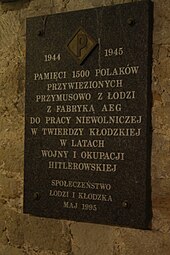
During World War II, the fortress was changed into a prison administered by the Reich Ministry of Justice and Wehrmacht.[15][16] It housed prisoners of various nationalities, including Allied prisoners of war. In 1941–1942, many prisoners were sent to forced labour in various locations in German-occupied Poland, Czechoslovakia and Austria, and in 1942–1943, six FStGA field penal battalions (1, 7, 10, 13, 16, 20) were established in the town and afterwards relocated to the Eastern Front.[16] In November 1942 and January 1943, the town was the site of a German trial of 39 members of the Związek Orła Białego Polish resistance organization, 18 of which were sentenced to death.[17] 198 prisoners were deported from the prison to various Nazi concentration camps, chiefly Gross-Rosen.[18] Presumably only two men, a Pole and a Russian, managed to escape from the prison (on 23 September 1944).[19] Beginning in 1944, the casemates housed the AEG arms factory evacuated from Łódź, in which some 1,500 Poles were subjected to slave labour. The stronghold was turned into a subcamp of the Gross-Rosen concentration camp. The Germans also established and operated eight forced labour subcamps of the Stalag VIII-B/344 POW camp in the town.[20]
In January and February 1945, many prisoners from other locations, including Katowice, Racibórz, Brzeg and Nysa, were brought to the local prison either during death marches or transports, and many were then sent further west to Bautzen.[21]
The town itself was not damaged by the war and was taken over by the Soviet Red Army without a major battle on 9 May 1945. However, all the bridges, except the Gothic stone bridge of 1390, were destroyed.
Modern Poland
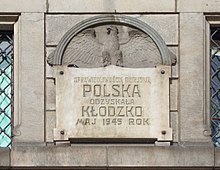
After the capitulation of
On August 20, 1946, the town was struck by a large tornado, rated by the European Severe Storms Laboratory (ESSL) to have been F2–F4 intensity on the Fujita scale. The ESSL documented the path length of the tornado at 10 kilometres (6.2 mi) with a maximum width of 1,000 metres (1,100 yd) and noted, "to less information to" assign a solid rating for the tornado.[22]
In the 1950s and 1960s much of the town centre was damaged by landslides. It turned out that throughout the city's history, generations of Kłodzko's merchants had developed an extensive net of underground basements and tunnels. They were used for storage and, in times of trouble, as a safe shelter from artillery fire. With time the tunnels were forgotten, especially after the original German population was deported, and during the years after World War II many of them started to collapse, along with the houses above. Since the 1970s the tunnels were conserved and the destruction of the city was stopped. Another disaster happened in 1997, when the city was damaged by flooding even greater than that of 1938. However, the town quickly recovered.
On 28 June 1972 the Catholic parishes of Kłodzko were redeployed from the traditional
Currently, Kłodzko is one of centres of culture, commerce and tourism in Lower Silesia.

Climate
The climate is semicontinental although officially it is considered as oceanic (Köppen: Cfb), near of the humid continental (Dfb), considered as such by the isotherm of 0 °C. Located in western Poland where there is the clash of marine air masses and the interior of Siberia, they collide and generate a highly variable climate, although the patterns of the west are predominant.[24][25][26]
| Climate data for Kłodzko, elevation: 320 m, (1991–2020 normals, extremes 1951–present) | |||||||||||||
|---|---|---|---|---|---|---|---|---|---|---|---|---|---|
| Month | Jan | Feb | Mar | Apr | May | Jun | Jul | Aug | Sep | Oct | Nov | Dec | Year |
| Record high °C (°F) | 16.3 (61.3) |
18.6 (65.5) |
23.0 (73.4) |
27.9 (82.2) |
31.7 (89.1) |
32.4 (90.3) |
34.8 (94.6) |
35.1 (95.2) |
33.9 (93.0) |
24.8 (76.6) |
18.5 (65.3) |
17.0 (62.6) |
35.1 (95.2) |
| Mean daily maximum °C (°F) | 1.2 (34.2) |
2.9 (37.2) |
7.3 (45.1) |
13.8 (56.8) |
18.2 (64.8) |
21.5 (70.7) |
23.8 (74.8) |
23.9 (75.0) |
18.4 (65.1) |
12.7 (54.9) |
6.8 (44.2) |
2.2 (36.0) |
12.7 (54.9) |
| Daily mean °C (°F) | −1.6 (29.1) |
−0.5 (31.1) |
2.9 (37.2) |
8.1 (46.6) |
12.5 (54.5) |
15.9 (60.6) |
17.7 (63.9) |
17.6 (63.7) |
13.0 (55.4) |
8.4 (47.1) |
3.9 (39.0) |
−0.3 (31.5) |
8.1 (46.6) |
| Mean daily minimum °C (°F) | −4.4 (24.1) |
−3.6 (25.5) |
−0.8 (30.6) |
2.6 (36.7) |
6.8 (44.2) |
10.3 (50.5) |
11.9 (53.4) |
11.5 (52.7) |
8.2 (46.8) |
4.8 (40.6) |
1.3 (34.3) |
−2.9 (26.8) |
3.8 (38.8) |
| Record low °C (°F) | −29.7 (−21.5) |
−28.8 (−19.8) |
−26.9 (−16.4) |
−10.2 (13.6) |
−4.1 (24.6) |
−0.5 (31.1) |
2.6 (36.7) |
0.8 (33.4) |
−4.1 (24.6) |
−7.6 (18.3) |
−19.3 (−2.7) |
−28.1 (−18.6) |
−29.7 (−21.5) |
| Average precipitation mm (inches) | 24.3 (0.96) |
24.6 (0.97) |
35.6 (1.40) |
37.3 (1.47) |
67.9 (2.67) |
83.7 (3.30) |
97.3 (3.83) |
72.8 (2.87) |
59.2 (2.33) |
41.8 (1.65) |
30.7 (1.21) |
26.1 (1.03) |
601.2 (23.67) |
| Average extreme snow depth cm (inches) | 6.2 (2.4) |
7.0 (2.8) |
5.2 (2.0) |
1.8 (0.7) |
0.2 (0.1) |
0.0 (0.0) |
0.0 (0.0) |
0.0 (0.0) |
0.0 (0.0) |
0.3 (0.1) |
2.7 (1.1) |
3.9 (1.5) |
7.0 (2.8) |
| Average precipitation days (≥ 0.1 mm) | 15.27 | 13.37 | 15.37 | 11.23 | 14.20 | 13.97 | 14.73 | 12.13 | 12.57 | 13.83 | 13.50 | 14.83 | 165.00 |
| Average snowy days (≥ 0 cm) | 17.7 | 14.5 | 7.4 | 1.4 | 0.0 | 0.0 | 0.0 | 0.0 | 0.0 | 0.2 | 4.0 | 11.8 | 57.0 |
| Average relative humidity (%)
|
85.5 | 82.6 | 78.8 | 72.2 | 74.9 | 76.5 | 75.7 | 75.2 | 80.2 | 83.4 | 86.3 | 86.6 | 79.8 |
| Mean monthly sunshine hours | 53.8 | 79.6 | 123.7 | 188.5 | 228.1 | 226.1 | 239.1 | 232.2 | 155.8 | 108.3 | 59.6 | 45.6 | 1,740.6 |
| Source 1: Institute of Meteorology and Water Management[27][28][29][30][31][32][33][34] | |||||||||||||
| Source 2: Meteomodel.pl (records, relative humidity 1991–2020)[35][36][37] | |||||||||||||
| Climate data for Kłodzko (Szalejów Dolny), elevation: 356 m, 1961-1990 normals and extremes | |||||||||||||
|---|---|---|---|---|---|---|---|---|---|---|---|---|---|
| Month | Jan | Feb | Mar | Apr | May | Jun | Jul | Aug | Sep | Oct | Nov | Dec | Year |
| Record high °C (°F) | 10.4 (50.7) |
17.2 (63.0) |
23.0 (73.4) |
27.8 (82.0) |
31.7 (89.1) |
32.4 (90.3) |
34.8 (94.6) |
32.5 (90.5) |
30.7 (87.3) |
24.1 (75.4) |
17.4 (63.3) |
17.0 (62.6) |
34.8 (94.6) |
| Mean daily maximum °C (°F) | 0.0 (32.0) |
1.9 (35.4) |
6.4 (43.5) |
12.2 (54.0) |
17.4 (63.3) |
20.5 (68.9) |
22.0 (71.6) |
21.9 (71.4) |
18.1 (64.6) |
12.9 (55.2) |
5.9 (42.6) |
1.7 (35.1) |
11.7 (53.1) |
| Daily mean °C (°F) | −2.7 (27.1) |
−1.3 (29.7) |
2.3 (36.1) |
6.9 (44.4) |
11.8 (53.2) |
14.9 (58.8) |
16.2 (61.2) |
15.8 (60.4) |
12.5 (54.5) |
8.2 (46.8) |
3.1 (37.6) |
−0.8 (30.6) |
7.2 (45.0) |
| Mean daily minimum °C (°F) | −5.7 (21.7) |
−4.4 (24.1) |
−1.3 (29.7) |
2.1 (35.8) |
6.3 (43.3) |
9.4 (48.9) |
10.6 (51.1) |
10.4 (50.7) |
7.9 (46.2) |
4.5 (40.1) |
0.5 (32.9) |
−3.6 (25.5) |
3.1 (37.5) |
| Record low °C (°F) | −29.7 (−21.5) |
−27.5 (−17.5) |
−26.9 (−16.4) |
−8.2 (17.2) |
−3.3 (26.1) |
−0.2 (31.6) |
2.6 (36.7) |
1.1 (34.0) |
−4.1 (24.6) |
−7.6 (18.3) |
−19.3 (−2.7) |
−26.9 (−16.4) |
−29.7 (−21.5) |
| Average precipitation mm (inches) | 22 (0.9) |
24 (0.9) |
27 (1.1) |
35 (1.4) |
74 (2.9) |
91 (3.6) |
86 (3.4) |
88 (3.5) |
47 (1.9) |
36 (1.4) |
38 (1.5) |
26 (1.0) |
594 (23.5) |
| Average precipitation days (≥ 1.0 mm) | 5.9 | 5.9 | 7.3 | 7.3 | 10.3 | 10.9 | 10.4 | 9.9 | 6.7 | 6.2 | 7.8 | 7.3 | 95.9 |
| Source: NOAA[38] | |||||||||||||
Tourist attractions

- Gothic bridge – often called a "Charles Bridge in miniature" due to its resemblance to one of the most notable historical monuments of Prague. The bridge survived a flood in 1997. The legend is that the bridge is made from eggs components.
- City tunnels – parts of the tunnels constructed under the city since the 13th century are open for the public
- The Church of Assumption – one of the most notable examples of Gothic architecture in Poland, constructed by the Order of Saint John in the 14th century
- Baroque Church of Our Lady of the Rosary and the Franciscan monastery
- The Frederick the Great, it was one of the largest fortresses in Prussia.
- Town hall, built in 1890, but the older Renaissancetower has been preserved
- Kłodzko Land Museum
- Marian Column – located at the market square, or the town square. It depicts the Blessed Virgin Mary and was constructed after a plague in 1625. This is a common sight in many other cities and towns that once belonged to the Habsburg monarchy.
-
Night view of the Gothic bridge
-
Interior of the Church of the Assumption
-
Our Lady of the Rosary church
-
Night view of the town hall
-
Franciscan monastery
-
Baroque sculptures of Jesuit saints in the Old Town
Education

Educational establishments in Kłodzko include:
- a branch of the Wrocław-based "Edukacja" College of Management
- the Bolesław Chrobry Lyceum (secondary school)
- Kłodzko's School of Enterprise (secondary school)
Notable residents
- Michael Friedrich von Althann (1680–1734), bishop and politician
- Gustav Adolf von Götzen (1866–1910), explorer
- Wilhelm Hemprich(1796–1825), scientist
- Emma Ihrer (1857–1911), politician
- Łukasz Krawczuk (born 1989), male sprinter
- Annelies Kupper (1906–1987), opera singer
- Friedrich Wilhelm von Lindeiner-Wildau (1880–1963), Luftwaffe officer
- Gabriela Muskała (born 1969), actress
- Weronika Nowakowska (born 1986), female biathlete
- David Origanus (1558–1628), mathematician
- Ernest of Pardubice (1297–1364), the first Archbishop of Prague
- Johann Christoph Pezel (1639–1694), composer
- Mirosław Pękala (born 1961), former Polish international footballer
- Oswald Rathmann (1891–?), cyclist
- Otto Reche (1879–1966), scientist
- Friedrich Wilhelm Riemer (1774–1845), secretary of Johann Wolfgang von Goethe
- Friedrich Wilhelm Sander (1885–1938), engineer
- Albrecht Schubert (1886–1966), Wehrmacht general
- Renée Sintenis (1888–1965), artist
- Maciej Soboń (born 1979), retired footballer
- Eduard Tauwitz (1812–1894), composer
- Sophie Charlotte Elisabeth Ursinus (1760–1836), serial killer
- Bogdan Zdrojewski (born 1957), politician
Surroundings
- Stołowe Mountains (Table Mountains) with Stołowe Mountains National Park
- Spa resorts in Polanica-Zdrój, Duszniki-Zdrój, Kudowa-Zdrój & Lądek-Zdrój
- Medieval town of Niemcza
- Cistercian monastery at Henryków
- Wojsławice Arboretum
- Gola Dzierżoniowska Castle
Twin towns – sister cities
See also
- Kłodzko Land
- County of Kladsko (historical)
Notes
- ^ "Population. Size and structure and vital statistics in Poland by territorial division in 2019. As of 30th June". stat.gov.pl. Statistics Poland. 2019-10-15. Retrieved 2020-02-14.
- ^ "Kłodzko - "Mała Praga" na wschodzie Czech - Bibliography of the History of the Czech Lands".
- ^ a b Jan Rzońca, Uzdrowiska ziemi kłodzkiej, "Ziemia Kłodzka" No. 223, 2013, p. 26 (in Polish)
- ISBN 978-1860649721
- ISBN 978-1145783386
- ^ Waldemar Brygier, Tomasz Dudziak, Ziemia Kłodzka. Przewodnik, Oficyna Wydawnicza Rewasz, Pruszków, 2010, p. 345 (in Polish)
- ^ "Dawne Kłodzko". Historical Kłodzko. Archived from the original on 2005-01-25. Retrieved January 10, 2005.
- ISBN 0-88029-158-3, p. 161
- ISBN 83-88513-00-1.
- ^ Wolniewicz, Paweł (2019). "Włodzimierz Adolf Dołęga Wolniewicz". Wieści Lubońskie (in Polish). No. 1 (338). p. 27.
- ^ Brygier, Waldemar; Dudziak, Tomasz (2010). Ziemia Kłodzka. Przewodnik (in Polish). Pruszków: Oficyna Wydawnicza Rewasz. p. 348.
- ^ Marek Weiss (26 March 2015). "Walczył z zaborcą jako kapłan, społecznik i działacz gospodarczy". Głos Wielkopolski (in Polish). Retrieved 6 March 2020.
- ^ a b Grzybowski, Henryk (2 February 2016). "Nieoczekiwane wskrzeszenie kłodzkiej synagogi" [Unexpected revival of the Kłodzko synagogue]. Gazeta Prowincjonalna Ziemi Kłodzkiej (in Polish). Retrieved 4 November 2019.
- ISBN 83-7432-095-8.
- Zakład Narodowy im. Ossolińskich, Wydawnictwo Polskiej Akademii Nauk: 370–371.
- ^ ISBN 978-0-253-06089-1.
- ^ Konieczny, pp. 379–380
- ^ Konieczny, p. 381
- ^ Konieczny, p. 380
- ^ "Working Parties". Lamsdorf.com. Archived from the original on 29 October 2020. Retrieved 11 November 2021.
- ^ Konieczny, pp. 377–378
- ^ "European Severe Weather Database". European Severe Storms Laboratory. Retrieved 8 December 2022.
- ^ Paulus VI, Constitutio Apostolica "Vratislaviensis - Berolinensis et aliarum", in: Acta Apostolicae Sedis, 64 (1972), n. 10, pp. 657seq.
- ISSN 1434-4483.
- ^ "Kłodzko climate: Average Temperature, weather by month, Kłodzko weather averages - Climate-Data.org". en.climate-data.org. Retrieved 2019-02-04.
- ^ "Klodzko vs No. 6 Climate & Distance Between". www.klodzko.climatemps.com. Retrieved 2019-02-04.
- ^ "Średnia dobowa temperatura powietrza". Normy klimatyczne 1991-2020 (in Polish). Institute of Meteorology and Water Management. Archived from the original on 3 December 2021. Retrieved 28 February 2022.
- ^ "Średnia minimalna temperatura powietrza". Normy klimatyczne 1991-2020 (in Polish). Institute of Meteorology and Water Management. Archived from the original on 15 January 2022. Retrieved 28 February 2022.
- ^ "Średnia maksymalna temperatura powietrza". Normy klimatyczne 1991-2020 (in Polish). Institute of Meteorology and Water Management. Archived from the original on 15 January 2022. Retrieved 28 February 2022.
- ^ "Miesięczna suma opadu". Normy klimatyczne 1991-2020 (in Polish). Institute of Meteorology and Water Management. Archived from the original on 9 January 2022. Retrieved 28 February 2022.
- ^ "Liczba dni z opadem >= 0,1 mm". Normy klimatyczne 1991-2020 (in Polish). Institute of Meteorology and Water Management. Archived from the original on 15 January 2022. Retrieved 28 February 2022.
- ^ "Średnia grubość pokrywy śnieżnej". Normy klimatyczne 1991-2020 (in Polish). Institute of Meteorology and Water Management. Archived from the original on 15 January 2022. Retrieved 28 February 2022.
- ^ "Liczba dni z pokrywą śnieżna > 0 cm". Normy klimatyczne 1991-2020 (in Polish). Institute of Meteorology and Water Management. Archived from the original on 21 January 2022. Retrieved 28 February 2022.
- ^ "Średnia suma usłonecznienia (h)". Normy klimatyczne 1991-2020 (in Polish). Institute of Meteorology and Water Management. Archived from the original on 15 January 2022. Retrieved 28 February 2022.
- ^ "Kłodzko Absolutna temperatura maksymalna" (in Polish). Meteomodel.pl. 6 April 2018. Retrieved 28 February 2022.
- ^ "Kłodzko Absolutna temperatura minimalna" (in Polish). Meteomodel.pl. 6 April 2018. Retrieved 28 February 2022.
- ^ "Kłodzko Średnia wilgotność" (in Polish). Meteomodel.pl. 6 April 2018. Retrieved 28 February 2022.
- ^ "Kłodzko (12520) - WMO Weather Station". NOAA. Retrieved January 4, 2019. Archived January 4, 2019, at the Wayback Machine.
- ^ "Miasta partnerskie". klodzko.pl (in Polish). Kłodzko. Retrieved 2019-10-09.
External links
- Municipal website
- Kłodzko commune (in Polish)
- Jewish Community in Kłodzko on Virtual Shtetl
- History of the Kladsko/Kłodzko land (in Czech)




